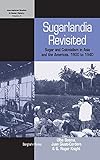Sugarlandia Revisited : Sugar and Colonialism in Asia and the Americas, 1800-1940 / ed. by Ulbe Bosma, G. Roger Knight, Juan A. Giusti-Cordero.
Material type: TextSeries: International Studies in Social History ; 9Publisher: New York ; Oxford : Berghahn Books, [2007]Copyright date: ©2007Description: 1 online resource (240 p.)Content type:
TextSeries: International Studies in Social History ; 9Publisher: New York ; Oxford : Berghahn Books, [2007]Copyright date: ©2007Description: 1 online resource (240 p.)Content type: - 9781845453169
- 9780857452429
- 382.4136 22
- online - DeGruyter
| Item type | Current library | Call number | URL | Status | Notes | Barcode | |
|---|---|---|---|---|---|---|---|
 eBook
eBook
|
Biblioteca "Angelicum" Pont. Univ. S.Tommaso d'Aquino Nuvola online | online - DeGruyter (Browse shelf(Opens below)) | Online access | Not for loan (Accesso limitato) | Accesso per gli utenti autorizzati / Access for authorized users | (dgr)9780857452429 |
Frontmatter -- Contents -- 1. Introduction -- 2. Sugarlandia Revisited: Sugar and Colonialism in Asia and the Americas, 1800 to 1940, An Introduction -- 3. Technology, Technicians and Bourgeoisie: Thomas Jeoffries Edwards and the Industrial Project in Sugar in Mid-Nineteenth-Century Java -- 4. An Anatomy of Sugarlandia: Local Dutch Communities and the Colonial Sugar Industry in Mid-Nineteenth-Century Java -- 5. Sugar and Dynasty in Yogyakarta -- 6. Hybridity, Colonial Capitalism and Indigenous Resistance: The Case of the Paku Alam in Central Java -- 7. ‘A Teaspoon of Sugar ...’: Assessing the Sugar Content in Colonial Discourse in the Dutch East Indies, 1880 to 1914 -- 8. Sugar, Slavery and Bourgeoisie: The Emergence of the Cuban Sugar Industry -- 9. The Spanish Immigrants in Cuba and Puerto Rico: Their Role in the Process of National Formation in the Twentieth Century (1898 to 1930) -- 10. Compradors or Compadres? ‘Sugar Barons’ in Negros (The Philippines) and Puerto Rico under American Rule -- Notes on Contributors -- Bibliography -- Index
restricted access online access with authorization star
http://purl.org/coar/access_right/c_16ec
Sugar was the single most valuable bulk commodity traded internationally before oil became the world’s prime resource. From the sixteenth to the eighteenth century, cane sugar production was pre-eminent in the Atlantic Islands, the Caribbean, and Brazil. Subsequently, cane sugar industries in the Americas were transformed by a fusion of new and old forces of production, as the international sugar economy incorporated production areas in Asia, the Pacific, and Africa. Sugar’s global economic importance and its intimate relationship with colonialism offer an important context for probing the nature of colonial societies. This book questions some major assumptions about the nexus between sugar production and colonial societies in the Caribbean and Southeast Asia, especially in the second (post-1800) colonial era.
Mode of access: Internet via World Wide Web.
In English.
Description based on online resource; title from PDF title page (publisher's Web site, viewed 25. Jun 2024)


